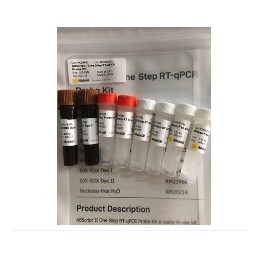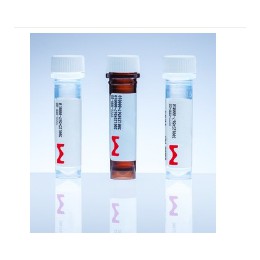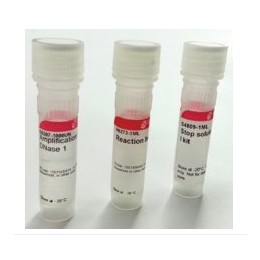
Ribonuclease H (RNase H) from Escherichia coli H 560 pol A1
Nonspecific endoribonuclease that specifically cleaves RNA in RNA:DNA hybrids. A minimum of four continuous base pairs (RNA:DNA) is required for activity. RNase H cleaves RNA to release 5′-oligoribonucleotides.
Source: E. coli H560 pol A1
Storage Buffer: 25 mM Tris-HCl, 50 mM KCl, 1 mM dithiothreitol, 0.1 mM EDTA, 50% glycerol (v/v), pH 8.0 (+4°C)
Volume Activity: 1 x 103 U/ml assayed according to Hillenbrand & Staudenbauer.
Ribonuclease H (RNase H) is a nonspecific endoribonuclease,[2] localized to the nucleus and cytoplasm.[3] It is ubiquitously found and widely present among many organisms including viruses and human.[4]
Ribonuclease H (RNase H) has been used for:
• In vivo RNA-primed initiation of DNA synthesis
• Elimination of mRNA during second-strand cDNA synthesis[1]
• Site-specific cleavage of RNA
• Detection
of RNA:DNA regions in double-stranded DNA of natural origin[6]
• Removal of poly (A) sequences of mRNA if oligo (dT) is present
• RNA extraction and quantitative reverse transcriptase polymerase chain
reaction (RT-PCR)[5]
Ribonuclease H (RNase H) specifically cleaves RNA in RNA:DNA hybrids.[2] A minimum of four continuous base pairs (RNA:DNA) is required for activity. RNase H cleaves RNA to release 5′-oligoribonucleotides. RNase H is associated with nucleic acid immunity.[2] Using RNase H for degrading mRNA results in 80% depletion of mRNA and protein expression. RNase H recognizes the start codon and the 3′ and 5′ untranslated regions.[3] This enzyme participates in DNA replication.[4]
• Eliminate potential sources of PCR errors.
• Increase accessibility of primers during subsequent PCR.
Absence of endonucleases, nicking activities, and ribonucleases.
RNase H is assayed according to Hillenbrand and Staudenbauer. One unit of RNase H is the amount of enzyme which produces 1 nmol acid-soluble ribonucleotides from[3H] poly(A) x poly(dT) in 20 minutes at +37 °C under the stated assay conditions.
Volume
Activity: Approximately 1 U/μl
Activator: The enzyme has its maximal activity in presence of SH-reagents
Store at -15–-25 °C. (unopened)
For life science research only. Not for use in diagnostic procedures. Using RNase H after the cDNA synthesis step can increase the sensitivity of a two-step RT-PCR assay.






.jpg)